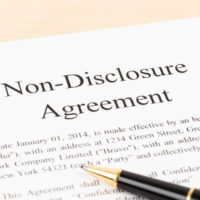Elements of a Non-Disclosure Agreement

In this information age, as high tech and information-based industries have grown, so has the need to keep valuable information secret. Non-disclosure agreements (NDAs), sometimes called confidentiality agreements, are legally binding contracts in which signing parties agree to protect confidential information from public release and unauthorized usage.
Entrepreneurs and employers should be familiar with what makes a strong NDA and consult qualified West Palm Beach business and corporate attorneys when drafting non-disclosure agreements.
Confidentiality Protection
When an NDA is signed, a legally binding relationship is formed between the party sharing the confidential information, the disclosing party, and the party receiving it, the recipient. Generally, this valuable information consists of trade secrets (such as product formulas or digital code) which give the disclosing party a market advantage.
Trade secrets need confidentiality protection since patents, which are part of the public domain, cannot safeguard them. A breach of confidentiality occurs when trade secrets are leaked. In this situation, Florida breach of contract attorneys should be consulted.
There are two types of non-disclosure agreements, one-way NDAs and mutual NDAs.
-
One-Way — Most common NDAs, especially within employment contracts, where only one party is expecting to disclose confidential information.
-
Mutual — NDAs used when both parties are expecting to disclose confidential information to each other.
Non-disclosure agreements must include these five basic elements, regardless of whether only one or all parties in the contract are sharing secret information.
- Identification of the Parties — Names the parties (the recipient, disclosing party, and any third parties) who must protect the confidential information.
- Definition of the Confidential Information — Identifies the disclosures (written, oral, or marked “Confidential”) that must be kept secret without revealing the specifics of that valuable information.
- Obligations and Duties of the Recipient — A two-part obligation, non-disclosure (prevents confidential information from being leaked to third parties) and non-use (prevents recipient stealing or using the information in an unauthorized way).
- Exclusions — Identifies information excluded from the confidential classification, typically information already known to the recipient or public. Also includes permitted disclosures to employees and contractors on a need-to-know basis.
- Time Period — Set amount of time the confidential information must be kept secret, usually a specific number of years (typically two to five years) or up to a future event.
Aside from the elements listed above, the disclosing party may want to add other provisions to the non-disclosure agreement to further limit the recipient’s actions and also ensure the disclosing party can quickly pursue legal remedies if a breach of confidentiality were to happen. Additional provisions typically include injunction clauses, jurisdiction clauses, and non-solicitation of employee clauses.
However, if a dispute or breach does occur, the legal counsel of Florida breach of contract attorneys will be necessary. Whether you are drafting non-disclosure agreements or fighting a breach of confidentiality, one of our experienced West Palm Beach business and corporate attorneys can help.
Call the Law Offices of Kelley Kaplan & Eller today for a consultation.



